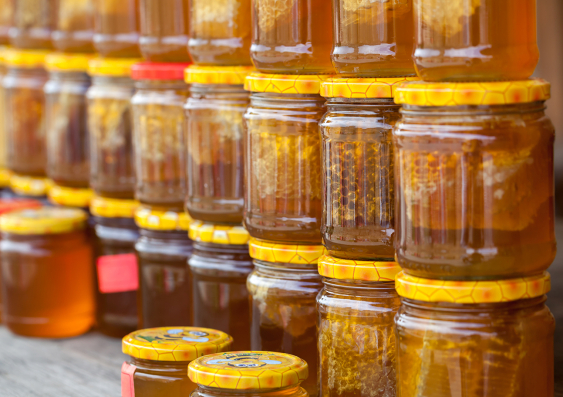When you think of fake products, you’d be forgiven for not having food items like honey at the top of your list.
Food fraud is a lucrative industry selling fake or misleading food products to consumers – and it’s on the rise. From meat and seafood to dairy – not even herbs are safe from food fraud.
Food fraud costs the Australian economy $3 billion every year, according to a report from AgriFutures Australia. Veal, wine, fish, and molluscs were identified as high-risk categories, with an estimated combined economic cost of between $700 million and $1.3 billion a year alone.
As the food and beverage supply chain become increasingly globalised, geopolitical and environmental factors put more pressure on the availability of raw ingredients – creating more opportunities for fraudsters to get away with it.
Food microbiologist, Associate Professor Julian Cox from UNSW School of Chemical Engineering, says the practice not only tarnishes consumer trust but it can pose as a food safety risk too like when harmful chemicals were found in baby formula.
“Consumers are left in the dark when producers substitute ingredients that could potentially cause adverse health reactions,” he says.
“Whether it’s buying honey or olive oil at the supermarket or going to a high-end restaurant and ordering expensive wagyu steak, as consumers, we expect to get what we pay for. It’s hard, or even impossible, for the consumer to know what is real and what is fake.
“And typically, we don’t question the product we’re buying because we put trust in something as fundamental as the food supply chain.”
Six types of food fraud
Food fraud comes in many forms but the end goal is still the same – to deceive the consumer into paying a higher price for a product that is not what it claims to be.
There are six types of food fraud practices that are prevalent in the food industry: mislabelling, adulteration, substitution, counterfeiting, dilution and concealment.
Adulteration occurs when fraudsters contaminate food by adding other substances to it, for example, adding sugar syrup to honey to lower cost. An example of concealment is when products are marketed as ‘organic’ or ‘halal’ but aren’t, yet charge more for it.
Other incidents of food fraud also involve making claims about the product’s country of origin, making false claims about how the product was made, misrepresenting the product’s nutritional qualities, and misrepresenting the weight of the food.
Earlier this year, it was reported that Booths, a UK supermarket chain, discovered one of its suppliers had falsely labelled imported beef as British.
The prepacked slices of beef and deli products were actually from another country in Europe and South America, and the case is now being investigated by the UK’s National Food Crime Unit.
“You can pick almost any commodity, any food or beverage, and you can almost guarantee that products within that category have been tampered with somewhere along the supply chain – even if it’s in the labelling and claiming to be from a specific region of the world,” says A/Prof. Cox.
“Currently, the vast majority of food recalls in Australia are due to issues with allergens.
“In these instances, while there is no intent, the problems boil down to mismanagement or mislabelling.
“Of course, when there’s a serious food safety risk, there’s less room for forgiveness, regardless of intent.”

The widespread adulteration of honey with sugar syrup defrauds consumers expecting a pristine, natural product.
Can one bad apple spoil the bunch?
Cases of food adulteration have been ruining the appetite of consumers for decades.
In 2013, a scandal over the contamination of meat products rocked parts of Europe. Frozen beef burgers and lasagne were found to contain horse DNA in more than one-third of samples, and pig DNA in 85 per cent of samples.
Unlike this case, others have been fatal – such as the 2008 Chinese milk scandal.
Sanlu Group’s milk and infant formulas were adulterated with the toxic industrial chemical melamine which resulted in the death of six infants after they developed kidney stones. It’s estimated that over 300,000 babies in China got sick from the contaminated milk.
While the Sanlu Group was identified as the culprit, the incident damaged the reputation of China’s food exports and was a shattering blow to their domestic dairy industry.
“When scandals like these occur, it can put a spotlight not just on the implicated supplier but on the entire industry,” says A/Prof. Cox.
“Repercussions such as global trade bans can occur if governments feel like the food exports from a certain country don’t meet a certain standard and the reputation of that industry is scrutinised.
“And a lot of the time, the primary producers aren’t aware that their product has been tampered with further along the food chain.
“Anytime there’s a way that you can pass off a product as something else, and make money doing it, there’ll be someone who’s tempted to defraud the consumer.”
What can we do about it?
While the onus of verifying the authenticity of a product should not fall on the customer, it is important that they ask questions if they have suspicions. However, A/Prof. Cox recognises this is easier said than done.
He says: “Unless you’re a true expert in that area, you’re probably not going to tell if the local fish and chip shop has sold you barramundi or if they’ve just sold you battered shark meat.”
There is no easy solution to this global problem, however, measures such as authenticity testing place emphasis on early detection and prevention – rather than reacting to issues once they occur.
Government intervention can also protect the industry from food fraud. Policies around minimum prices for materials can ensure producers, wholesalers and retailers are getting a fair cut.
“It’s always in the best interest of the farmers and food distributors themselves to make sure the consumers are getting what they’re paying for,” he says.
“Thankfully, now we have DNA technology which makes it easy to take a quick extract of tissue of meat to determine if it’s really what it’s labelled as.
“In some cases, we have low-tech options. For example, the freezing point is a very old test that industry can use. For example, the freezing point of milk can indicate if water has been added.
“These measures can help protect the integrity of the industry and thus ensuring that food quality and safety is not compromised.”










